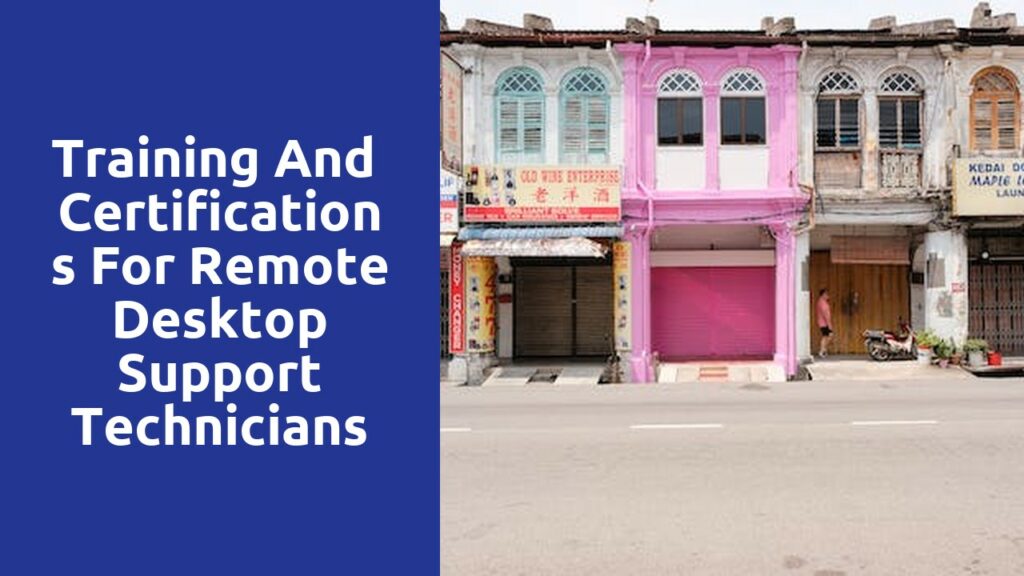Understanding the Role of a Remote Desktop Support Technician
One of the key players in the IT support industry is the remote desktop support technician. This vital role involves assisting clients with their technical issues from a remote location. As technology has advanced and businesses have become more globalized, the need for remote desktop support technicians has increased significantly. These professionals are responsible for troubleshooting and resolving various computer and software-related problems for clients located anywhere in the world.
A remote desktop support technician requires a wide range of skills and expertise in order to excel in this field. Firstly, they must have an in-depth understanding of computer hardware and software technologies. This knowledge enables them to identify and solve technical issues efficiently. Additionally, remote desktop support technicians must possess exceptional problem-solving and communication skills. They must be able to troubleshoot problems remotely, communicate instructions clearly to clients, and provide superior customer service. In a fast-paced environment, these professionals must also possess the ability to multitask effectively, showing great agility in handling multiple support requests simultaneously.
Exploring the Fundamentals of Remote Desktop Support
Remote desktop support has become an essential tool for businesses and individuals in today’s technological landscape. It enables users to access and control a computer or device remotely, providing assistance without the physical need to be present. This technology has revolutionized the way technical support is delivered, allowing experts to troubleshoot issues and offer solutions from anywhere in the world.
One of the key elements of remote desktop support is the use of specialized software. This software acts as a bridge between the user’s device and the remote computer, facilitating communication and control. With just a few clicks, support representatives can establish a secure connection, granting them access to diagnose and resolve technical problems. Moreover, this software often includes additional features such as file transfer and remote printing, enhancing the overall experience and making troubleshooting more efficient. By leveraging this technology, remote desktop support minimizes downtimes and maximizes productivity for businesses and individuals alike.
Building a Strong Foundation in Computer Hardware and Operating Systems
The world of computers is rapidly evolving, and having a strong foundation in computer hardware and operating systems is becoming more essential than ever. This foundation serves as the backbone for understanding the inner workings of computers and allows individuals to troubleshoot and fix technical issues that may arise. Furthermore, a solid understanding of computer hardware and operating systems enables individuals to make informed decisions when it comes to purchasing and upgrading computer components.
Starting with computer hardware, it is crucial to understand the various components that make up a computer system. These include the central processing unit (CPU), random access memory (RAM), hard disk drive (HDD), graphics processing unit (GPU), and more. Knowing how these components interact with one another and contribute to the overall performance of a system is essential for any computer enthusiast or professional. Additionally, learning about the different types of hardware and their compatibility with different operating systems is crucial for making informed decisions when it comes to building or upgrading a computer system.
Moving on to operating systems, it is important to have a solid grasp of different platforms such as Windows, macOS, Linux, and more. Each operating system has its own unique features, user interface, and compatibility with various software applications. Understanding the strengths and weaknesses of different operating systems allows individuals to select the one that best suits their needs and preferences. Moreover, learning how to navigate and customize an operating system enables individuals to increase their productivity and efficiency in using computers for both personal and professional purposes.
In conclusion, building a strong foundation in computer hardware and operating systems is a fundamental step for anyone looking to excel in the world of technology. By diving deep into the realm of computer hardware, individuals gain the knowledge needed to troubleshoot and upgrade systems effectively. Simultaneously, understanding different operating systems empowers individuals to make informed decisions and maximize the potential of their computer systems. With a strong foundation in computer hardware and operating systems, individuals can confidently navigate the ever-evolving world of technology and stay ahead in this rapidly advancing field.
Mastering Troubleshooting Techniques for Remote Desktop Support
When it comes to remote desktop support, mastering troubleshooting techniques is crucial for providing effective and efficient assistance to users. Having the ability to diagnose and resolve issues remotely not only saves time and resources, but it also ensures a seamless user experience. But how can one become proficient in troubleshooting techniques for remote desktop support?
First and foremost, a thorough understanding of the remote desktop software being used is essential. Whether it’s TeamViewer, AnyDesk, or Remote Desktop Protocol (RDP), familiarizing oneself with the software’s features and functionalities is paramount. This knowledge allows the support technician to navigate the software quickly and efficiently, enabling them to troubleshoot issues effectively. Additionally, being well-versed in common error codes, system messages, and known bugs specific to the remote desktop platform can further expedite the troubleshooting process.
Developing Proficiency in Network Connectivity and Configuration
Networking is a vital aspect of any modern business environment. To ensure smooth and efficient operations, it is crucial for professionals to develop proficiency in network connectivity and configuration. Without a properly functioning network, businesses may experience downtime, communication gaps, and potential security breaches.
One way to enhance proficiency in network connectivity is through comprehensive training courses. These courses provide individuals with the knowledge and skills needed to set up, troubleshoot, and maintain network connections. Professionals who invest in such training not only ensure that their organizations have robust and reliable networks but also position themselves as valuable assets within their respective industries. In addition, gaining proficiency in network configuration allows professionals to optimize network resources, allocate bandwidth effectively, and implement security measures to safeguard sensitive data.
Acquiring Skills in Software Installation and Configuration for Remote Support
With the increasing demand for remote support in today’s digital landscape, acquiring skills in software installation and configuration has become a crucial aspect of professional development. In order to effectively troubleshoot and assist clients remotely, it is essential for support technicians to possess a strong foundation in software installation and configuration techniques.
One of the key steps in acquiring these skills is gaining hands-on experience with a variety of software applications. By actively participating in software installation and configuration processes, technicians can develop a deeper understanding of the intricacies involved. This can be achieved by working on real-world projects, collaborating with experienced professionals, or even setting up virtual environments for practice purposes. This practical experience enables technicians to become familiar with the different types of software installations, as well as the configurations required for optimal performance and compatibility. Additionally, actively engaging with software installation and configuration allows technicians to identify and troubleshoot common problems that may arise, preparing them to handle similar situations in the future.
Related Links
Training and Certifications for Remote Desktop Support Technicians
Remote Desktop Support vs Onsite Support: Pros and Cons

